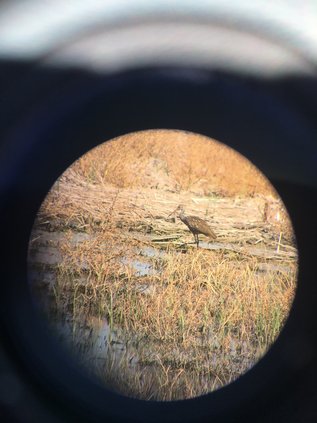

Attention area bird-watchers: Have you ever seen a limpkin?
If your normal watching territory is Cheyenne Bottoms, chances are that you haven’t. In its history, the Bottoms has provided an opportunity to view more than 350 bird species but, until recently, never a limpkin.
That’s because their native habitat is Florida, stretching down to the Caribbean, Mexico and into South America.
“They just haven’t made it this far north before,” noted Kansas Wetlands Education Center Director Curtis Wolf. “They are a tropical wetland bird.”
Never, that is, until last year. Wolf noted that for some reason, they’ve been seen throughout the Midwest United States and up into the Great Plains.
Earlier this month, Wolf had the privilege of confirming a limpkin sighting at the Bottoms just after Labor Day weekend.
“It was actually spotted first on the Saturday before Labor Day,” he said. “There were some people who were in and they got photos of it and then came to the Education Center. It was spotted again on that Sunday, Monday and Tuesday. That was the last I had seen it reported.”
Two birdwatchers who just happened to be on site were able to photograph a single limpkin on the first day among the pools. Madeline and Cheryl Dykstra snapped the first photo on Sept. 2. Two birds were observed by staff from The Nature Conservancy on Tuesday, Sept. 5 and Christopher Frick got another several photos to confirm the sighting with the Kansas Rare Bird Alert website on Sept. 9, Wolf said.
Far from home
The limpkin, also called the “crying bird,” (genus Aramus, species guarauna) is the only living member of its genus group, although other species are known from the fossil record as far back as the Miocene. Limpkins look like a large rail, but are skeletally closer to cranes. The bird generally weighs between two and three pounds with the long, spindly legs and decurved bill of a marshland wader. Their coloring is brown, with white spots on the back and sides.
There have been unconfirmed sightings in Eastern Kansas since June 2022, and Wolf has a thought as to why.
“They are a tropical wetland species, and it’s pretty rare to see them up north,” he said. “I don’t think that they are much of a migratory species.
“Their main diet is snails. From what I’ve read, they are following the invasive snails that have expanded their range to the north as well. We don’t really have these types of snails here, but the birds have started venturing out and keep going.
“There has been a pretty good handful seen in Kansas over the past year, so we knew that it would just be a matter of time before they showed up here at the Bottoms,” he said.
“They’ve just been on a long road trip, and wanted to stop and get something to eat along the way. It’s a brand new species, one that has been documented here at the Bottoms for the first time.”
Counting the limpkin, there have been 357 different species documented at the Bottoms to date.
Bottoms conditions improving
Cheyenne Bottoms has more water than it did a year ago, when it was completely dry due to a prolonged drought. Rains earlier this summer and in the past few weeks have provided some inflow into the storage pools of Cheyenne Bottoms; however, the rains did not fill up the refuge. Pool 1A has held some water since June. Pool 2 has numerous isolated pools. Pool 3A has recently been flooded with water from Pool 1A in anticipation of the current Teal season.
While over half of Cheyenne Bottoms is still dry, the areas that have standing water have been very active with migrating shorebirds, waders, and waterfowl.





